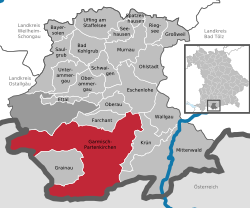Garmish-Partenkirchen
| Garmisch-Partenkirchen | ||
|---|---|---|

Garmisch-Partenkirchen with Alpspitze and Zugspitze
|
||
|
||
| Coordinates: 47°30′N 11°5′E / 47.500°N 11.083°ECoordinates: 47°30′N 11°5′E / 47.500°N 11.083°E | ||
| Country | Germany | |
| State | Bavaria | |
| Admin. region | Oberbayern | |
| District | Garmisch-Partenkirchen | |
| Government | ||
| • Mayor | Thomas Schmid (Chr.Soziales Bündnis/Bürger für GAP e.V.) | |
| Area | ||
| • Total | 205.66 km2 (79.41 sq mi) | |
| Population (2015-12-31) | ||
| • Total | 26,821 | |
| • Density | 130/km2 (340/sq mi) | |
| Time zone | CET/CEST (UTC+1/+2) | |
| Postal codes | 82467 | |
| Dialling codes | 08821 | |
| Vehicle registration | GAP | |
| Website | garmisch-partenkirchen.de | |
Garmisch-Partenkirchen (German pronunciation: [ˈɡaʁmɪʃ paʁtn̩ˈkɪʁçn̩]; Southern Bavarian: Garmasch-Partakurch) is a mountain resort town in Bavaria, southern Germany. It is the administrative centre of the district of Garmisch-Partenkirchen, in the Oberbayern region, and the district is on the border with Austria. Nearby is Germany's highest mountain, Zugspitze, at 2,962 m (9,718 ft.).
The town was the site of the 1936 Winter Olympic Games.
Garmisch (in the west) and Partenkirchen (in the east) were separate towns for many centuries, and still maintain quite separate identities.
Partenkirchen originated as the Roman town of Partanum on the trade route from Venice to Augsburg and is first mentioned in the year A.D. 15. Its main street, Ludwigsstrasse, follows the original Roman road.
Garmisch is first mentioned some 800 years later as Germaneskau ("German District"), suggesting that at some point a Teutonic tribe took up settlement in the western end of the valley.
During the late 13th century, the valley, as part of the County of Werdenfels, came under the rule of the prince-bishops of Freising and was to remain so until the mediatization of 1803. The area was governed by a prince-bishop's representative known as a Pfleger (caretaker or warden) from Werdenfels Castle situated on a crag north of Garmisch.
The discovery of America at the turn of the 16th century led to a boom in shipping and a sharp decline in overland trade, which plunged the region into a centuries-long economic depression. The valley floor was swampy and difficult to farm. Bears, wolves and lynxes were a constant threat to livestock. The population suffered from periodic epidemics, including several serious outbreaks of bubonic plague. Adverse fortunes from disease and crop failure occasionally led to a witch hunt. Most notable of these were the trials and executions of 1589–1596, in which 63 people — more than 10 percent of the population at the time — were burned at the stake or garroted.
...
Wikipedia



